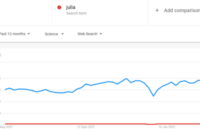Why Python continues to reign supreme on the job market sets the stage for this enthralling narrative, offering readers a glimpse into a story that is rich in detail and brimming with originality from the outset. Python, the versatile and powerful programming language, has become a cornerstone of the tech industry, its popularity soaring across various domains.
From web development to data science, machine learning to scripting, Python’s adaptability and user-friendly nature have made it a go-to choice for programmers and developers alike.
But what exactly fuels Python’s enduring dominance? The answer lies in a combination of factors: its versatility, a robust community, an approachable learning curve, and a growing demand in the job market. Let’s dive deeper into these key aspects that have cemented Python’s position as a top contender in the programming landscape.
Python’s Versatility and Wide Applicability
Python’s versatility is a key factor driving its popularity in the job market. Its simple syntax, extensive libraries, and robust frameworks make it suitable for a wide range of applications across various domains. This adaptability allows developers to solve complex problems efficiently and effectively, making Python a valuable asset in diverse industries.
Web Development
Python is widely used for web development due to its powerful frameworks like Django and Flask. These frameworks simplify the development process by providing pre-built components and tools for handling tasks like routing, database interactions, and user authentication.
- Djangois a high-level framework that follows the Model-View-Controller (MVC) architectural pattern. It emphasizes rapid development, clean code, and scalability, making it suitable for complex web applications.
- Flaskis a lightweight framework that provides more flexibility and control over application structure. It is often preferred for smaller projects or when developers need a more customized approach.
Python’s web development frameworks offer advantages like:
- Rapid Development:Pre-built components and tools accelerate the development process, allowing developers to build applications quickly.
- Scalability:Frameworks like Django are designed to handle large-scale applications with high traffic volumes.
- Security:Frameworks include built-in security features to protect applications from common vulnerabilities.
Data Science
Python has become the go-to language for data science due to its extensive libraries for data manipulation, analysis, and visualization. These libraries provide powerful tools for tasks like data cleaning, statistical analysis, and machine learning.
Get the entire information you require about this is what the future of coworking should look like on this page.
- NumPyis a fundamental library for numerical computing, providing efficient array operations and mathematical functions.
- Pandasis a library for data analysis and manipulation, offering data structures like DataFrames for organizing and working with structured data.
- Matplotlibis a plotting library that provides tools for creating static, interactive, and animated visualizations.
Python’s data science libraries offer advantages like:
- Comprehensive Functionality:Libraries like NumPy, Pandas, and Matplotlib offer a wide range of tools for data manipulation, analysis, and visualization.
- Ease of Use:Python’s syntax is intuitive and easy to learn, making it accessible to both beginners and experienced data scientists.
- Active Community:Python’s large and active community provides ample resources, support, and collaboration opportunities.
Machine Learning
Python’s extensive machine learning libraries, like scikit-learn and TensorFlow, have made it a popular choice for developing machine learning models. These libraries provide algorithms for tasks like classification, regression, clustering, and deep learning.
- Scikit-learnis a library that offers a wide range of machine learning algorithms, including support vector machines, random forests, and k-nearest neighbors.
- TensorFlowis a library for building and deploying deep learning models, providing tools for training and deploying neural networks.
Python’s machine learning libraries offer advantages like:
- Ease of Implementation:Libraries like scikit-learn and TensorFlow provide high-level APIs that simplify the implementation of machine learning models.
- Performance:Libraries like TensorFlow are optimized for performance, allowing developers to train and deploy large-scale machine learning models efficiently.
- Flexibility:Python’s machine learning libraries support a wide range of algorithms and frameworks, providing flexibility in model selection and development.
Scripting
Python’s simple syntax and ease of use make it an ideal choice for scripting tasks. It can be used to automate repetitive processes, manage system administration tasks, and interact with other applications.
- System Administration:Python can be used to automate tasks like managing system resources, monitoring system performance, and deploying software.
- Data Processing:Python can be used to process data from various sources, including files, databases, and APIs.
- Web Scraping:Python libraries like Beautiful Soup and Scrapy can be used to extract data from websites.
Python’s scripting capabilities offer advantages like:
- Efficiency:Python scripts can automate repetitive tasks, saving time and effort.
- Flexibility:Python can interact with various systems and applications, making it a versatile scripting language.
- Readability:Python’s clear and concise syntax makes scripts easy to understand and maintain.
Strong Community Support and Resources

Python’s popularity is not just due to its versatility but also because of its vibrant and supportive community. This community plays a crucial role in making Python accessible and fostering continuous learning.
The Size and Activity of the Python Community
The Python community is vast and active, encompassing millions of developers worldwide. This massive community ensures a constant flow of new ideas, solutions, and support. The sheer number of Python users contributes to the language’s rapid evolution and the availability of a wide range of resources.
Popular Python Forums, Online Communities, and Documentation Resources
The Python community offers a wealth of resources to support learners and experienced developers alike. Some prominent examples include:
- Stack Overflow:This platform is a go-to resource for developers facing coding challenges. It hosts a vast repository of questions and answers related to Python and other programming languages.
- Python.org:The official website of Python provides comprehensive documentation, tutorials, and resources for learning and using the language.
- Reddit’s r/Python:This subreddit serves as a forum for Python enthusiasts to discuss various topics, share projects, and seek help.
- Python Discord Servers:Several Discord servers dedicated to Python provide a platform for real-time discussions, collaboration, and community support.
How These Resources Contribute to Python’s Ease of Learning and Problem-Solving
The availability of these resources significantly contributes to Python’s ease of learning and problem-solving. Here’s how:
- Access to Solutions:Forums and online communities provide a platform for developers to find solutions to common and complex problems, saving time and effort.
- Learning Opportunities:Tutorials, documentation, and community discussions offer numerous opportunities for learning new concepts and techniques.
- Collaboration and Support:The collaborative nature of the community fosters a sense of shared learning and support, making it easier for developers to overcome challenges.
Beginner-Friendly Syntax and Learning Curve: Why Python Continues To Reign Supreme On The Job Market
Python’s syntax is renowned for its simplicity and readability, making it an excellent choice for beginners. This accessibility is a key factor in its widespread adoption and popularity.
Python’s Syntax Compared to Other Languages
Python’s syntax is designed to be clear and concise, resembling natural language more closely than many other programming languages. This makes it easier for beginners to understand and write code. For example, consider the following code snippets:* Python:“`pythonprint(“Hello, world!”)“`* Java:“`javapublic class HelloWorld public static void main(String[] args) System.out.println(“Hello, world!”); “`* C++:“`cpp#include Python’s readability is further enhanced by its use of indentation to define code blocks. This eliminates the need for curly braces or other symbols, resulting in a more organized and visually appealing code structure.Here’s an example of a simple Python function:“`pythondef greet(name): “”” This function greets the user with a personalized message. “”” print(“Hello, ” + name + “!”)greet(“Alice”)“`This code snippet clearly shows the structure of the function using indentation, and the docstring (within triple quotes) provides a concise explanation of its purpose. This level of clarity makes Python code easier to read, understand, and maintain. Python’s straightforward syntax and intuitive structure make it an ideal language for beginners. This accessibility has led to a large and active community of Python learners and developers, creating a wealth of resources and support for newcomers. The ease of learning Python encourages individuals with diverse backgrounds to explore the world of programming, contributing to its widespread adoption and popularity. The demand for Python skills continues to surge across industries, solidifying its position as a highly sought-after language in the job market. This sustained growth is driven by Python’s versatility, its ability to handle complex tasks, and its increasing adoption in various sectors. The demand for Python skills is not limited to specific industries but spans across various sectors, indicating its widespread applicability. Examples of Python Code Snippets
Python’s Beginner-Friendly Nature Attracts New Programmers
Growing Demand in the Job Market
Demand for Python Skills in Various Industries
Trends in Job Postings and Salary Expectations, Why python continues to reign supreme on the job market
The growing demand for Python skills is reflected in the increasing number of job postings and the competitive salaries offered to Python developers.
- Job Postings:According to Indeed.com, the number of job postings mentioning “Python” has significantly increased in recent years, indicating a consistent rise in demand for Python professionals.
- Salary Expectations:The average salary for Python developers has also been on the rise, reflecting the high demand and value placed on these skills. Glassdoor.com reports that the average base salary for Python developers in the United States is around $110,000 per year.
Increasing Adoption of Python in Various Sectors
The increasing adoption of Python in various sectors is a key driver of its job market dominance.
- Cloud Computing:Python is widely used in cloud computing platforms like AWS, Azure, and Google Cloud. As cloud adoption continues to grow, the demand for Python professionals with cloud expertise is expected to increase.
- Internet of Things (IoT):Python is playing a significant role in the development of IoT applications. Its ability to interact with hardware devices and analyze sensor data makes it a valuable tool for IoT development.
- Big Data and Analytics:Python’s data manipulation and analysis capabilities are essential for handling large datasets. As big data and analytics become more prevalent, the demand for Python professionals with expertise in these areas is expected to rise.
- Artificial Intelligence (AI):Python is the language of choice for AI development. Its libraries and frameworks for machine learning and deep learning are widely used in AI projects.
Python’s Role in Emerging Technologies

Python’s adaptability and versatility have made it a dominant force in emerging technologies, particularly in fields like artificial intelligence (AI), big data analytics, and cloud computing. Python’s vast libraries and frameworks cater specifically to these technologies, enabling developers to create innovative solutions that drive progress in these areas.
Python in Artificial Intelligence
Python’s role in AI is undeniable, with its powerful libraries like TensorFlow, PyTorch, and scikit-learn enabling the development of sophisticated AI models.
Key Python Libraries for AI:
- TensorFlow:A widely-used open-source library for numerical computation and large-scale machine learning, developed by Google. It excels in deep learning tasks like image recognition, natural language processing, and time series analysis.
- PyTorch:A popular open-source machine learning library developed by Facebook. It provides a dynamic computation graph, making it highly flexible for research and prototyping. PyTorch is known for its ease of use and strong community support.
- scikit-learn:A powerful library for machine learning algorithms, including classification, regression, clustering, and dimensionality reduction. It offers a comprehensive range of tools for building and deploying machine learning models.
Python in Big Data Analytics
Python’s role in big data analytics is equally significant, with its libraries like Pandas, NumPy, and Dask providing efficient data manipulation and analysis capabilities.
Key Python Libraries for Big Data Analytics:
- Pandas:A powerful library for data manipulation and analysis, offering data structures like DataFrames and Series for efficient data handling. Pandas is widely used for data cleaning, transformation, and analysis.
- NumPy:A fundamental library for numerical computing in Python, providing support for multi-dimensional arrays and matrices. NumPy’s efficient array operations are essential for scientific computing and data analysis.
- Dask:A library that scales Python’s data analysis tools to larger-than-memory datasets. Dask enables parallel processing, allowing efficient analysis of massive datasets that exceed the memory capacity of a single machine.
Python in Cloud Computing
Python plays a crucial role in cloud computing, with its libraries like Boto3, Google Cloud SDK, and Azure SDK facilitating interactions with cloud platforms.
Key Python Libraries for Cloud Computing:
- Boto3:The official Python library for interacting with Amazon Web Services (AWS). Boto3 provides a comprehensive interface for managing various AWS services, including EC2, S3, and Lambda.
- Google Cloud SDK:A set of tools for interacting with Google Cloud Platform (GCP). The SDK provides command-line tools and Python libraries for managing various GCP services, including Compute Engine, Cloud Storage, and BigQuery.
- Azure SDK for Python:A library for interacting with Microsoft Azure. The SDK provides tools for managing Azure services, including virtual machines, storage, and databases.





